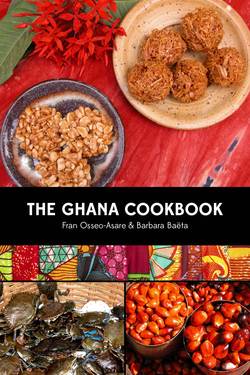Читать книгу The Ghana Cookbook - Fran Osseo-Asare - Страница 14
На сайте Литреса книга снята с продажи.
ОглавлениеCracking the Mysteries of the Coconut
Coconuts are widely used in many world cuisines, including African, Brazilian, Asian, and Indian. “Fresh” coconuts in North America mean the brown hairy ones with hard shells sold in the produce section. In Ghana they call those “dried,” and when they say “fresh” coconut they mean the literally fresh green ones right off the trees, often sold with the tops whacked off with a machete right in front of you. Those coconuts are soft and gelatinous inside, and you can drink the coconut water right out of them, scooping the meat up with a spoon or a piece of shell.
Opening Coconuts & Extracting Coconut Water
There is more than one way to crack open a hard brown coconut. This is a fun activity to do with children and young adults—just make sure that they stand back when someone is swinging the hammer. If your coconut shows any signs of mold, return it to the store where it was purchased and get a refund. I generally buy two coconuts when I need one, just in case.
Tools
hammer
ice pick or similar sharp implement (I’ve used screwdrivers, clean nails, and the meat pick from a nut cracker set)
newspapers
large towel
cup, tall glass, or small pitcher
fine strainer
knife and/or vegetable peeler
Remember that the liquid extracted in Step 3 is NOT coconut “milk” (see page 28). It is coconut water, found both in the brown and the green coconuts. It makes a healthy, refreshing drink and has become somewhat of a fad in grocery stores in North America, where its health benefits are increasingly exalted and it is hailed as a sports drink and anti-aging wonder drink. It is sold canned, but is easy to obtain directly from a coconut.
For those with more patience and less preference for hammering, one can also put a cracked-open coconut on a cookie sheet or baking dish in a medium preheated oven (350 degrees F) for about half an hour or until the meat pulls away from the shell.
Directions
1. I usually crack open coconuts in my garage where I have a cement floor, but it can also be done indoors. Spread a few newspapers under the coconut and turn it up so you see the three “eyes” at one end. Place the ice pick, or whatever you are using, in the center of one of the eyes, and hammer it through the eye to make a hole and then wiggle it around to enlarge the hole and remove it. Repeat the process with the other 2 eyes.
2. Turn the coconut over a glass, cup, or small pitcher (use a tea strainer to keep out bits of shell) and let the coconut water run into it. Always try to buy a “juicy” coconut (shake them in the store before you buy).
3. After removing the liquid from the coconut, move the glass or cup to a safe place, and wrap the coconut with a towel to avoid flying coconut pieces. Put the coconut down on the floor and begin hammering away. Many times there will be a small line around the center of the coconut that has been made to make it easier to crack the coconut open. If there is such a line, aim at it or otherwise at the center (not the ends). When the coconut begins cracking open, keep pounding away until many of the pieces of the white meat have broken off from the shell (they will have a brown coating on one side). The rest can be pried off carefully with a knife. You may have to unwrap it a few times to check, and even leave the towel off near the end.
4. Use a vegetable peeler to remove the brown skin from the coconut, which can be cut or broken into pieces and served that way, or grated or chopped into fruit salads or other recipes.
Making Coconut Milk
Coconut milk is made from the meat of the coconut, either fresh or dried. While canned coconut milk is available and convenient, it is expensive and has emulsifiers/preservatives in it. It is possible to hand-grate fresh coconut meat for this recipe (no need to remove the brown peel after taking off the shell) but I prefer using organic dried grated unsweetened coconut.
Tools and Ingredients
blender
cheesecloth
strainer or colander
large bowl
Scant cup dried unsweetened grated coconut (preferably organic)
1½ cups hot water
Directions
1. Put a scant cup of the dried coconut into a blender container. Pour in 1 cup of the hot water and blend for 2 or 3 minutes.
2. Place the colander or strainer over a large bowl and line it with the cheesecloth. Pour the coconut-water mixture from the blender into the cheesecloth, using a spatula to scrape it all in.
3. Pick up the cheesecloth from the ends and twist to get all the liquid out and into the bowl. Put the coconut in the cheesecloth back into the blender and add another ½ cup of hot water and blend again for 1 or 2 minutes and then repeat the process with the cheesecloth. Discard the coconut dregs or use for added fiber in baking.
4. Pour the coconut milk into a jar and store for up to a few days in the refrigerator.
Make ahead:I always use my coconut milk as soon as I make it, but you can also freeze leftovers in an ice cube tray to use later. After freezing, store the cubes in the freezer in a covered container.
To use: The coconut cream rises to the top and can be used like cream or stirred back into the milk when using.
